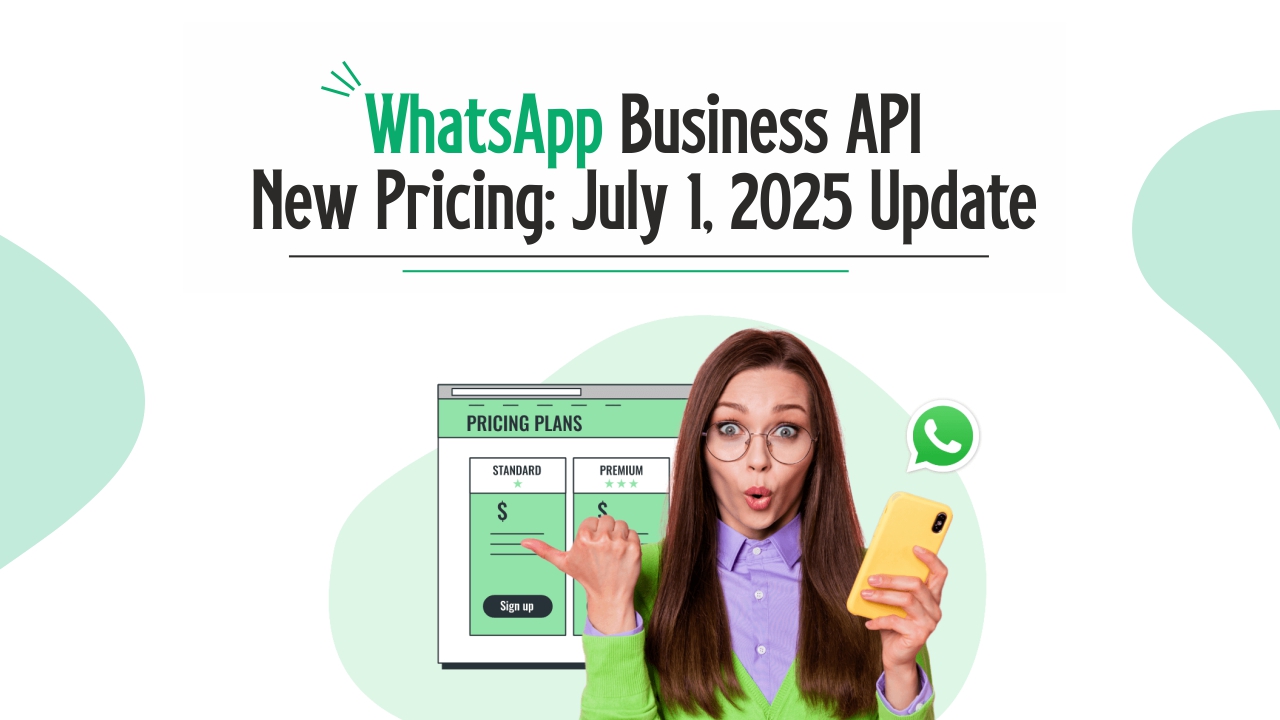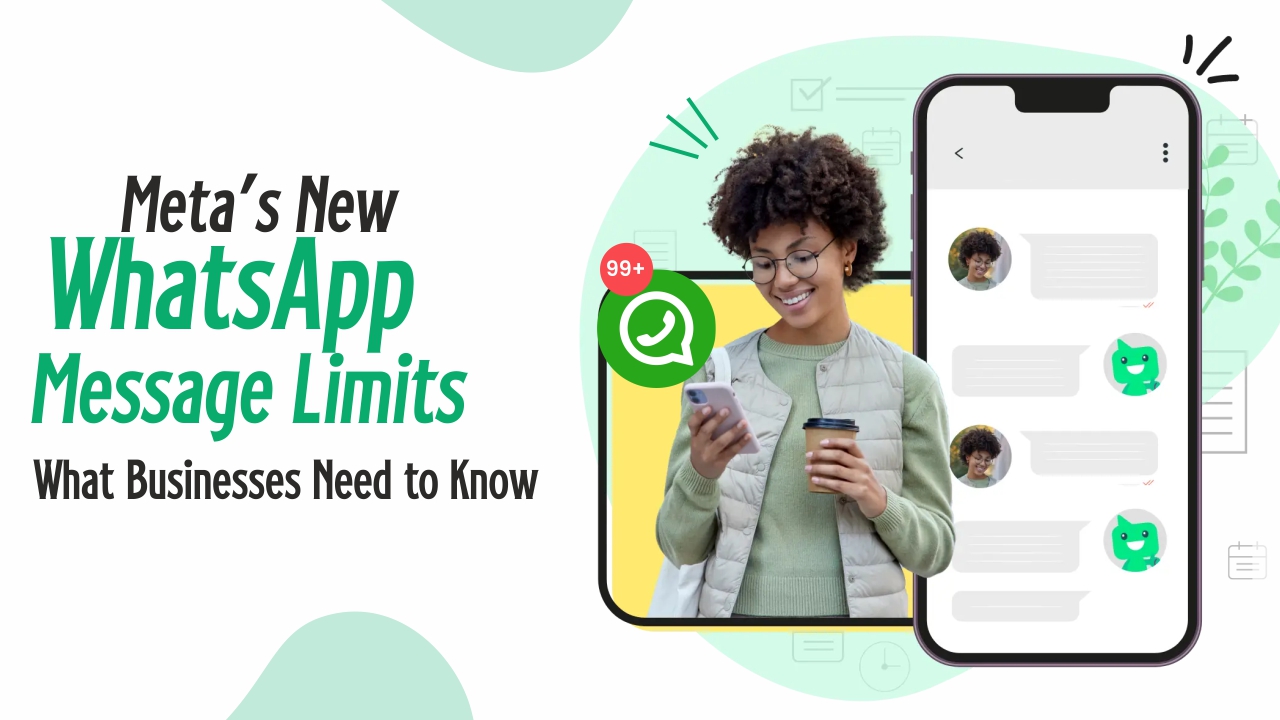WhatsApp Business API Pricing is changing from July 1, 2025: What You Need to Know

Meta has announced a major update to WhatsApp’s conversation-based pricing model, set to take effect on July 1, 2025. This change will significantly impact how businesses are billed for sending messages via the WhatsApp Business Platform.
Here’s everything you need to know about this pricing transition, what it means for your business, and how you can adapt strategically.
The Changed Scenario: From Conversation to Template Billing
Previously, when your business sent an outbound template message, it opened a 24-hour conversation window. All subsequent messages exchanged within that window generally falls under that initial conversation charge. This is changing.
Here’s the new breakdown, effective July 1, 2025:
- Billing will now be per template message sent, instead of per 24-hour conversation. This applies to Marketing, Utility, and Authentication template messages.
- Service messages and Utility messages sent within an active customer service window remain FREE. This is crucial for customer support.
Let’s illustrate this with an example:
Old Scenario (Before July 1, 2025):
Imagine a customer, Megha, who browses your e-commerce store and abandons her cart.
On Day 1 at 10:00 AM, you sent a “Cart Abandonment Reminder” (Marketing Template message, which will open a 24-hour conversation window. The incurred cost will be 1 Marketing conversation charge. During this conversation window, you can send unlimited marketing template messages to Megha, free of cost, up until 10:00 AM the next day.
Later at 01:00 PM, Megha completes the purchase. You send an “Order Confirmation” (Utility Template), which will open a separate 24-hour utility conversation window. The incurred cost will be 1 Utility conversation charge. During this window, you can send unlimited utility template messages to Megha.
At 02:30 PM, Megha receives a “Shipment Detail” (Utility Template) message, which will be in the same pre-opened 24-hour utility conversation window; thus, no charge will be incurred. Likewise, at 05:00 PM, you send a “Delivery Update” (Utility Template), again free within the 24-hour window.
Next Day at 09:00 AM, you send a “Feedback Request” (Marketing Template), which is free within the original 24-hour window. But, sending a “Special Offer” message at 10:02 AM will open a new marketing conversation window, thus incurring a marketing template cost.
Total cost under this old model: 3 conversation charges (2 Marketing, 1 Utility).
New Scenario (From July 1, 2025 onwards):
Let’s use the same example with Megha:
On Day 1 at 10:00 AM, you sent a “Cart Abandonment Reminder” (Marketing Template). Meta charges for this Marketing Template message.
At 01:00 PM, Megha completes the purchase, and you send an “Order Confirmation” (Utility template). Meta charges for this Utility Template message.
At 05:00 PM, you send a “Shipping Update” (Utility Template). Again, Meta charges for this Utility Template message.
The Next Day at 09:00 AM, you send a “Feedback Request” (Marketing Template message). Meta again charges for this Marketing Template message.
Total cost under the new model: 4 separate template message charges (2 Marketing, 2 Utility).
Here, Meta has ended the concept of opening a new chat window with every Template Message reception. You will be charged for sending every new BIC template message now.
So, if Megha were to reply to your “Cart Abandonment Reminder” and then you exchanged free-form messages or Utility messages within the 24-hour customer service window (initiated by Megha’s response), those specific messages would still be free. The change primarily impacts business-initiated template messages sent outside of an active customer-initiated service window.
Meta will permit you to send Unlimited Utility Template Messages to Megha if the conversation was initiated by her, i.e., when the service conversation or the UIC chat window opens up. So, if Megha inquires about the Delivery Status of her cancelled purchase, thus opening the service window, then you can, as a Business, send n number of pre-set utility template messages to address and resolve her issue, all free of cost.
Why Did Meta Make Such a Move?
Meta’s decision to shift to a per-template message pricing model aligns with several strategic objectives:
To Standardizing Pricing
The new pricing model brings an adapted payment model of other messaging channels like SMS, making it easier for businesses to compare costs as well as better understand their Business ROI. You can gain better control and transparency over your marketing spending.
To Encourage Value-Driven Communication
Meta dictates that businesses send more relevant, high-quality messages by charging for each template. This ensures businesses add value to the customer experience as well as discourages “spammy” messaging for a better user experience on WhatsApp.
To Refine Template Definitions
The change pushes businesses to be more precise in categorizing their messages. With Utility templates being free within the customer service window, it emphasizes WhatsApp’s role as a robust customer support channel. Marketing messages, which are inherently promotional, will now be charged per send.
To Reward Customer Service
By keeping service messages and utility templates within an active customer service window for free, Meta is actively encouraging businesses to use WhatsApp for responsive and effective customer support, fostering stronger customer relationships.
Implications for Businesses Indulging in Daily Bulk Marketing
For businesses that heavily rely on daily bulk marketing campaigns via WhatsApp, these pricing changes will have a significant impact:
How their Marketing Cost will soar:
Under the previous model, sending multiple marketing or utility templates within the same 24-hour conversation window might have only incurred a single conversation charge. Now, each Marketing, Utility (sent outside the service window), or Authentication template message delivered will be charged separately. This directly translates to a potential increase in marketing costs, especially if your campaigns involve multiple follow-up templates or a series of promotional messages within a short span. The more templates you send, the higher your bill will be.
What Businesses can do to keep their Bulk Marketing budget in check from July 1?
While costs may increase, businesses can implement several strategies to manage and optimize their WhatsApp marketing spend:
Merge Messages
Review your existing template flows. You can combine two or three short, sequential templates into a single comprehensive one that delivers the relevant information. The template must be highly impactful and concise to drive the desired action by sending a single template.
Encourage User-Initiated Conversations
You can use “Click-to-WhatsApp” buttons on your website, social media, ads, etc., which prompt customers to initiate contact and open up a 24-hour free window. With this, you can send unlimited free-form messages as well as free Utility templates.
Send Messages to Genuine Recipients
Instead of broad blasts, you can deeply segment your audience to ensure marketing messages are sent only to those most likely to convert or engage. This is called a highly targeted campaign that leads to better Business ROI.
Use Interactive Buttons and List Messages
Use interactive buttons and list messages within your templates to guide conversations and capture information efficiently. This can reduce the need for multiple follow-up templates by allowing users to select options or provide input directly within the initial message.
Automate Responses within the Service Window
Utilize chatbots to handle common queries and provide instant support during the free service window, preventing the need for chargeable template messages.
Design Intelligent Flows
Map out your customer journeys to identify where free messages can be used versus where a paid template is unavoidable.
Track Message Costs granularly
Work with your Meta Business Partner or WhatsApp API platform to get detailed breakdowns of your message costs per category, as well as recipient country.
Analyze Campaign Performance
After open rates, one can also focus on conversion rates as well as ROI per message to truly understand the effectiveness of WhatsApp Marketing efforts.
By adapting to these new changes, Businesses can continue to leverage the power of WhatsApp for effective customer engagement without seeing a spike in their marketing costs. This is a time to refine marketing strategies and prioritize value to build a stronger and meaningful connection with your audience.
Categories
About the Writer
Sumant Kumar
Related Articles

Meta-issued WhatsApp Marketing Amendments from June 1
“The said changes will be implemented from June 1, 2023. Every Business using WhatsApp A

Updates to Conversation Based Pricing
Conversation categories and how they apply to your pricing By utilizing a template message

WhatsApp Conversation Pricing Changes Timeline
Due to recent updates to WhatsApp Conversation Types and Pricing by Meta, we request that

Meta’s New WhatsApp Message Limits: What Businesses Need to Know
Meta has always strived to evolve WhatsApp into a more powerful channel for excellent cust
Request An Immediate Call Back
Enter your number to request a callback. Our team will get in touch with you within five minutes.

 September 17, 2025
September 17, 2025